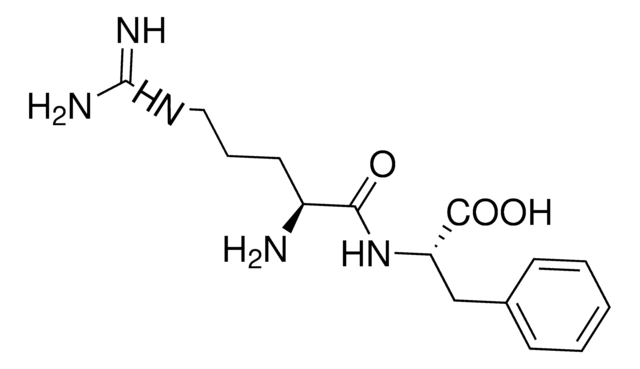M3129
Met-Gly
≥98% (TLC)
Autenticatiper visualizzare i prezzi riservati alla tua organizzazione & contrattuali
About This Item
Formula empirica (notazione di Hill):
C7H14N2O3S
Numero CAS:
Peso molecolare:
206.26
Numero CE:
Numero MDL:
Codice UNSPSC:
12352202
ID PubChem:
NACRES:
NA.26
Prodotti consigliati
product name
Met-Gly,
Saggio
≥98% (TLC)
Livello qualitativo
Forma fisica
powder
Colore
white
Temperatura di conservazione
−20°C
Stringa SMILE
OC(CNC([C@@H](N)CCSC)=O)=O
InChI
1S/C7H14N2O3S/c1-13-3-2-5(8)7(12)9-4-6(10)11/h5H,2-4,8H2,1H3,(H,9,12)(H,10,11)/t5-/m0/s1
QXOHLNCNYLGICT-YFKPBYRVSA-N
Azioni biochim/fisiol
Met-Gly is a dipeptide.
Codice della classe di stoccaggio
11 - Combustible Solids
Classe di pericolosità dell'acqua (WGK)
WGK 3
Punto d’infiammabilità (°F)
Not applicable
Punto d’infiammabilità (°C)
Not applicable
Certificati d'analisi (COA)
Cerca il Certificati d'analisi (COA) digitando il numero di lotto/batch corrispondente. I numeri di lotto o di batch sono stampati sull'etichetta dei prodotti dopo la parola ‘Lotto’ o ‘Batch’.
Possiedi già questo prodotto?
I documenti relativi ai prodotti acquistati recentemente sono disponibili nell’Archivio dei documenti.
J C Matthews et al.
Journal of animal science, 73(11), 3464-3475 (1995-11-01)
The absorption of carnosine, methionine, and methionylglycine (using 35S-methionine and 35S-methionylglycine as representative markers) across ruminal and omasal epithelia collected from four (carnosine) and seven sheep (methionine and methionylglycine) were studied using parabiotic chambers that were repeatedly sampled over a
Olga B Morozova et al.
The journal of physical chemistry. B, 113(20), 7398-7406 (2009-05-15)
Time-resolved chemically induced dynamic nuclear polarization (CIDNP) was applied to the investigation of the photo-oxidation of two sulfur containing peptides, glycylmethionine (Gly-Met) and methionylglycine (Met-Gly). It was established that the reaction of Gly-Met with a photosensitizer, triplet 4-carboxybenzophenone, occurs via
Justin Kai-Chi Lau et al.
Journal of the American Society for Mass Spectrometry, 24(4), 543-553 (2013-02-27)
Radical cations [Met-Gly](•+), [Gly-Met](•+), and [Met-Met](•+) have been generated through collision-induced dissociation (CID) of [Cu(II)(CH3CN)2(peptide)](•2+) complexes. Their fragmentation patterns and dissociation mechanisms have been studied both experimentally and theoretically using density functional theory at the UB3LYP/6-311++G(d,p) level. The captodative structure
Urszula Rychlewska et al.
Acta crystallographica. Section C, Crystal structure communications, 66(Pt 2), m51-m54 (2010-02-04)
Crystallographic analysis of a solid solution of two diastereoisomers, i.e. ({(1S,R)-1-carboxy-3-[(R,S)-methylsulfinyl]propyl}aminocarbonyl)methanaminium tetrachloridoaurate(III) and ({(1S,R)-1-carboxy-3-[(S,R)-methylsulfinyl]propyl}aminocarbonyl)methanaminium tetrachloridoaurate(III), (C(7)H(15)N(2)O(4)S)[AuCl(4)], has shown that in the presence of gold(III), the methionine part of the Gly-D,L-Met dipeptide is oxidized to sulfoxide, and no coordination to the
Snežana Rajković et al.
Bioinorganic chemistry and applications, 2018, 3294948-3294948 (2018-06-02)
Dinuclear platinum(II) complexes, [{Pt(en)Cl}2(μ-qx)]Cl2·2H2O (1), [{Pt(en)Cl}2(μ-qz)](ClO4)2 (2), and [{Pt(en)Cl}2(μ-phtz)]Cl2·4H2O (3), were synthesized and characterized by different spectroscopic techniques. The crystal structure of 1 was determined by single-crystal X-ray diffraction analysis, while the DFT M06-2X method was applied in order to
Il team dei nostri ricercatori vanta grande esperienza in tutte le aree della ricerca quali Life Science, scienza dei materiali, sintesi chimica, cromatografia, discipline analitiche, ecc..
Contatta l'Assistenza Tecnica.